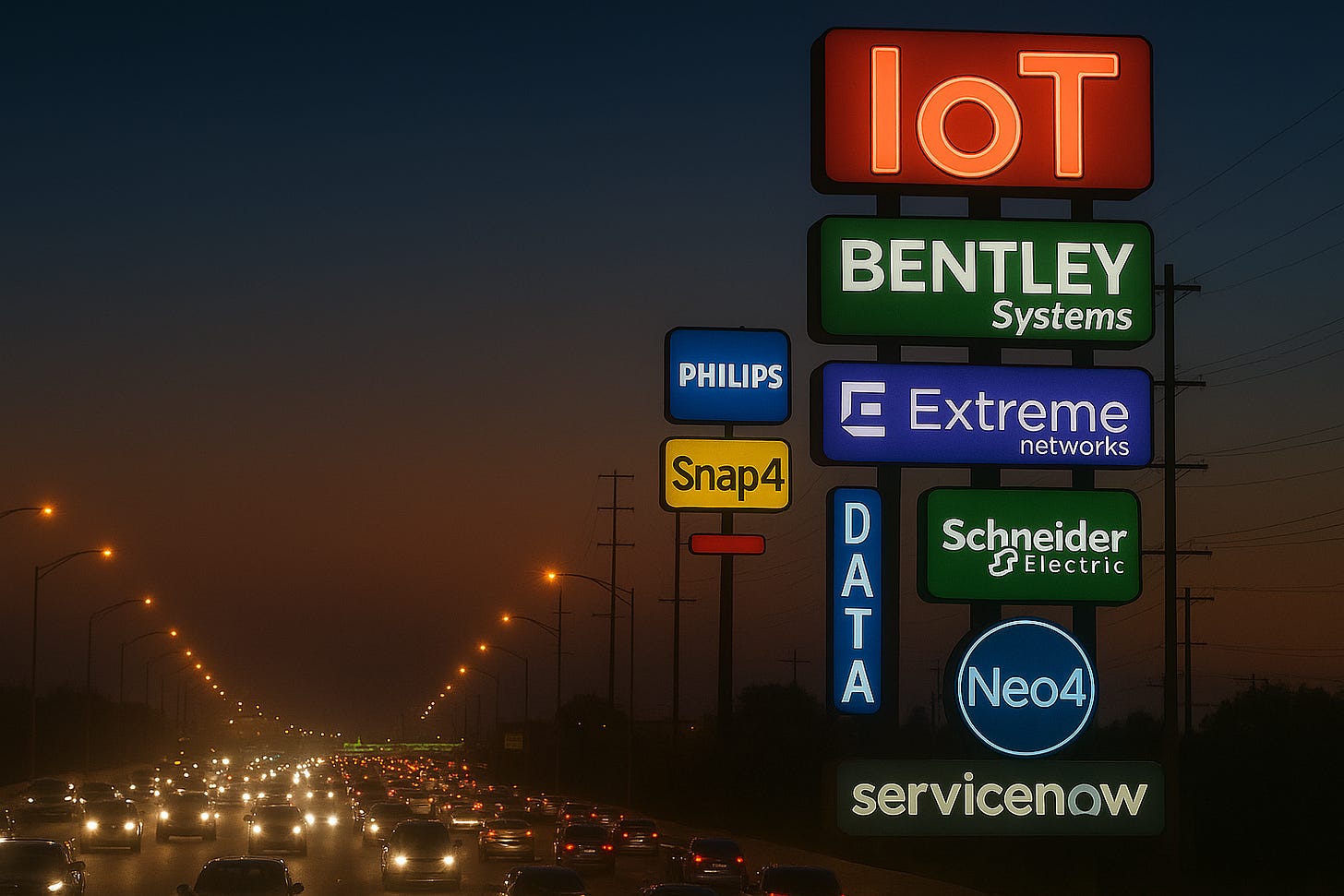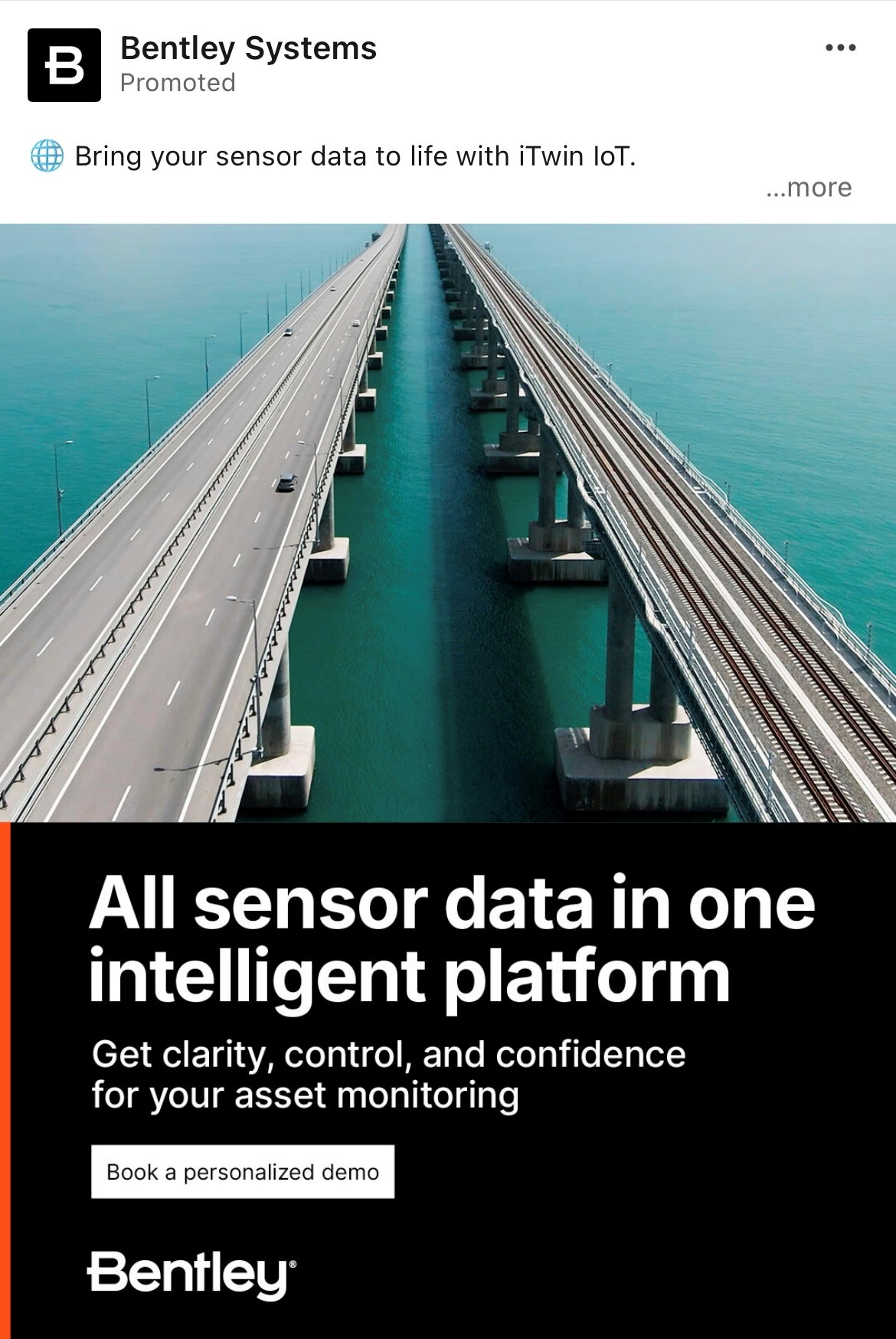The New Digital Campus
Where IoT, Networks, and Digital Twins Redefine How We Manage Place
A Bentley Systems ad slid through my Instagram feed last week (I’ve posted it later in the article). It depicts a bridge stretching across calm blue water. Clean symmetry, the promise of precision. It read, “All sensor data in one intelligent platform”. Bring your sensor data to life with iTwin IoT. It was a small thing, but it stopped me. Not because of the ad itself, but because of what it represented. It’s a resurgence in the quiet convergence of infrastructure, telecommunications, and software into something that looks less like asset management and more like urban governance.
And what struck me most was that it’s not new. In fact, part of the reason I paused was because I’ve seen this cycle before, and it feels like it’s on the rise again. It’s been more than a decade since I first sat in a conference room at the now-demolished Mirage in Las Vegas during an early Amazon Web Services event and watched the commercial birth of IoT devices into enterprise platforms.
It was one of those moments that genuinely altered the course of my career, leading me to take on the role of City Innovation Director for one of Australia’s capital cities. I spent four remarkable years helping to kick start the digitisation of the city’s physical assets. Everything from parking, lighting, energy, bridges, parks, and transport into data models that could help rethink how the city managed outcomes, not just assets.
That’s why the Bentley ad caught me. It wasn’t just the precision of the bridge. It was the memory of that same promise, resurfacing a decade later in sharper focus.
In that image I didn’t just see a bridge. I saw a campus. The kind with buildings, roads, pipes, and poles. The kind that behaves like a miniature city but runs under a single operating budget.
Airports, hospitals, ports, universities, and recreation precincts have become the new frontier for digital transformation. They are self-contained economies, each with multiple classes of assets, thousands of endpoints, and an emerging expectation that everything within their boundaries can be not just monitored or modelled, but connected and continuously available and responsive to the people and businesses who depend on them.
Back in that first wave, the conversation was dominated by connectivity itself. By LoRaWAN, Sigfox, and other low-power, low-bandwidth networks that made it possible to instrument the physical world cheaply and at scale. They opened the field but also defined its limits due to narrow pipes, patchy reach, and constrained intelligence.
That’s where the real collision is happening now. The convergence of IoT, 5G, digital twins, and network intelligence isn’t just a technical shift. It’s an architectural one. It is a battle over who defines the truth about the physical world when it becomes software.
Every major vendor now sees this layer as strategic and its time we did too.
Schneider Electric approaches it from energy and building automation, wrapping every pump, motor, and HVAC unit in an efficiency story. Philips (Signify) extends its lighting heritage into connected luminaries and adaptive control systems, where a single light pole can act as a node for sensors, cameras, or Wi-Fi. Bentley Systems, traditionally the domain of engineers and civil modellers, is pushing iTwin as a digital-twin-driven data layer that spans sensors, structures, and spatial analytics1. IDT Snap4 takes the open-data route, trying to free telemetry from proprietary formats and feed it into whatever analytical engine the owner prefers.
And then there’s ServiceNow, which most people don’t think of as an IoT company at all. Yet its CMDB quietly absorbs IoT events through API connectors, allowing real-world devices to exist as configuration items that trigger workflows, incidents, and maintenance logic. It’s not about visualisation. It’s about operationalisation. Where Bentley might model a bridge, ServiceNow wants to orchestrate its upkeep, compliance, and lifecycle events through the same platform that handles HR requests and cybersecurity incidents.
This is the point where categories start to blur. The traditional notion of a campus management system becomes less about booking rooms or scheduling maintenance and more about managing a distributed, living infrastructure. A pole might contain a light, a sensor, a camera, and a 5G antenna. Each one is technically a different asset class, often belonging to different data hierarchies, yet all share the same physical coordinates and power source.
That blurring isn’t new. It’s just harder now. In most organisations, the physical estate has always been fragmented across multiple divisions. Property owns the buildings, engineering owns the road and energy networks, operations manages the maintenance, and IT historically stayed in the background. But the rise of new technology buying centres through digital experience teams, sustainability functions, and innovation hubs has layered new complexity over the old.
The result is a genuine decision point for CIOs and digital leaders. When every asset produces data and every division wants control, who actually defines the source of truth?
The hidden player in all of this is, of course, the network. Every connected object depends on a backbone that is itself transforming. 5G and Wi-Fi 6 are no longer just telco evolutions, they are the enablers of this municipal mesh. They collapse the boundary between public and private infrastructure, between what’s owned and what’s provisioned. Suddenly, a university network looks more like a telco. Every access point, switch, and gateway becomes part of an ambient computing fabric.
That’s where companies like Extreme Networks re-enter the conversation. For years, networking felt like plumbing. It was critical but invisible. Now, as IoT architectures scale, the network has become the nervous system that determines visibility, security, and performance. CIOs who once treated it as background infrastructure are being forced to re-elevate it to a strategic discipline. The network defines the enterprise perimeter, the latency of sensor data, and ultimately the credibility of the digital twin itself.
The industry is circling back to a phrase that used to make architects groan. The single pane of glass. It is the idea that all operational data, from lighting to elevators to air quality to asset depreciation, can be viewed and managed through one unified interface.
It failed the first time (I was there), because it was tech-led and data models and protocols and governance were too fragmented. But today’s digital-twin ecosystems, combined with service orchestration platforms, might finally make it viable. The pane of glass this time isn’t actually a dashboard. It is more like an ontology where that shared language connects telemetry (tech) to context (outcomes).
So when Bentley speaks of iTwin IoT, what it really signals is the merging of civil engineering with live operational data. When ServiceNow extends the CMDB into IoT, it blurs the line between IT and facilities. When Schneider and Philips embed intelligence into their respective domains, they move from product vendors to platform participants. Each is competing to become the anchor of the digital campus, and by extension, of the digital city.
For CIOs and CTOs, this presents a new dilemma. Where to centre digital engineering gravity in a world where every system is trying to pull the enterprise into its own orbit. Which layer should become the organising centre of the organisation’s digital fabric? The twin, the network, or the service platform?
If you lead with the digital twin, the world looks like geometry and assets. If you lead with the service platform and it looks like workflows and incidents. Lead with the network and it looks like packets and policies.
Each approach is rational, but each yields a different form of governance. And really, that’s potentially just more of the same blur that will perpetuate the same overlapping lines of ownership and accountability. Only now it will be amplified by data, automation, and expectation.
The challenge isn’t to choose one.
In fact, most organisations already have versions of all three, often multiplied by department or vendor. The strategic opportunity is to rationalise the sprawl and start by anchoring around a single organising principle for the layer that best aligns with how the organisation actually governs itself.
The most advanced campuses will still weave all three together. I think the future is a twin for context, a network for sensing, and a service layer for action. But they’ll do so deliberately, with clear lines of ownership and a defined centre of gravity. I can’t wait to see the global partner models emerge in this space in the coming years.
And this is why the campus has become such a revealing unit of analysis. It’s small enough to manage but complex enough to mirror the systems of a city. It contains every challenge that municipalities face. It has multiple vendors, overlapping asset classes, fragmented data, competing operational logics, and the constant tension between centralisation and autonomy. If we can learn how to govern a campus digitally, we may have the blueprint for governing cities themselves.
What Bentley’s ad hinted at, perhaps unintentionally, is that the next wave of digital transformation won’t be about apps or analytics. It will be about alignment and getting infrastructure, information, and intent to inhabit the same architectural space.
And that’s the real frontier.
When every pole, light, and pump speaks, the question isn’t how to listen. It’s how to make them agree on what they’re saying.
The city government I worked for did a PoC with Bentley Systems’ Digital Twin software in the early 2020’s.



